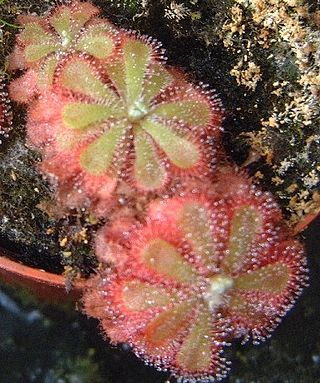
The copper-rumped hummingbird is a species of hummingbird in the "emeralds", tribe Trochilini of subfamily Trochilinae. It is found in Tobago, Trinidad, Venezuela, and possibly Grenada.

Drosera aliciae, the Alice sundew, is a carnivorous plant in the family Droseraceae. It is native to the Cape Provinces of South Africa, like Drosera capensis, the cape sundew, and is one of the most common sundews in cultivation. The plant forms small, tight rosettes of wedge-shaped leaves, up to 5 cm in diameter. Under conditions of good lighting, the insect-snagging tentacles will become deeply coloured with anthocyanin pigments, which probably aid in its attraction of insect prey. The plant is relatively easy to grow, and produces attractive scapes of pink flowers, which are held about 30 cm away from the carnivorous leaves, so as to prevent pollinators from becoming ensnared. D. aliciae is very similar in form to a number of other closely related species such as D. slackii, and D. natalensis: the former is rather larger with a slightly different growth habit(8 cm diameter); the latter has hairier stipules and a larger distance between leaf base and the “sticky” trichomes.

Cynanchum is a genus of about 300 species including some swallowworts, belonging to the family Apocynaceae. The taxon name comes from Greek kynos and anchein, hence the common name for several species is dog-strangling vine. Most species are non-succulent climbers or twiners. There is some evidence of toxicity.

Pseudophoenix is a genus of palms which is native to the wider Caribbean. Three species of the four species are endemic to Hispaniola, while the fourth, P. sargentii, is widely distributed in the northern Caribbean, Florida, and the Yucatán Peninsula.

Bromelioideae is a subfamily of the bromeliads (Bromeliaceae). This subfamily is the most diverse in the family, represented by the greatest number of genera with about 40. Most of the plants in this group are epiphytes, though some have evolved in, or will adapt to, terrestrial conditions. This subfamily features the most plant types which are commonly cultivated by people, including the pineapple.

Matelea is a genus of flowering plants in the family Apocynaceae. It contains about 200 species, which are commonly known as milkvines. Some people consider Chthamalia to be a synonym to or a subgenus of Matelea.

Odontonema, the toothedthreads, is a genus of flowering plants in the family Acanthaceae. It includes 32 species native to the tropical Americas, ranging from Mexico to Peru and southeastern Brazil.

Mystacidium, abbreviated as Mycdm in horticultural trade, is a genus of the orchid family (Orchidaceae). It is native to eastern and southern Africa from Tanzania to South Africa.

Watsonisuchus is an extinct genus of temnospondyl from the Early Triassic of Australia, Madagascar, and South Africa. It was up to 122 cm long and had a robust skull of 24 cm in length.
Navia aliciae is a species of plant in the genus Navia. This species is endemic to Venezuela. It was first described by Lyman B. Smith and Harold Robinson.

Warrenisuchus is an extinct genus of temnospondyl from the Early Triassic of Queensland, Australia. It belongs to a diverse group of Triassic temnospondyls called Capitosauria. The type species Warrenisuchus aliciae was erected in 2009. W. aliciae was originally described as a species of Parotosuchus in 1988, which is known from other species that have been found in Europe, Africa, and Antarctica. In 2000 it was then assigned to a new genus called Rewanobatrachus along with the newly named species R. gunganj, which was declared the type species of the genus. However, R. gunganj was later reclassified as a species of Watsonisuchus, invalidating the name Rewanobatrachus and requiring that R. aliciae be placed in its own genus, which was named Warrenisuchus. However, several studies suggest that Warrenisuchus aliciae may be a species of Watsonisuchus as well. Unlike most capitosaurs, Warrenisuchus is known from many juvenile skulls less than 4 centimetres (1.6 in) in length.
Pentacyphus is a genus of plants in the family Apocynaceae, first described as a genus in 1906. It is native to South America.

Ibatia is a genus of flowering plants belonging to the family Apocynaceae.
Rhytidostemma is a genus of flowering plants belonging to the family Apocynaceae.
Pseudolachnostoma is a genus of flowering plants belonging to the family Apocynaceae.
Phaeostemma is a genus of flowering plants belonging to the family Apocynaceae.
Orinoquia yanomamica is a species of flowering plant in the dogbane family, Apocynaceae. It is a climber endemic to Amazonas state of southern Venezuela. It is the sole species in genus Orinoquia. The species was first named Matelea yanomamica by Gilberto Morillo in 1981. In 2015 Morillo moved the species to its own genus.
Graciemoriana gracieae is a species of flowering plant in the dogbane family, Apocynaceae. It is the sole species in genus Graciemoriana. It is endemic to French Guiana.
Riparoampelos amazonicus is a species of flowering plant in the dogbane family, Apocynaceae. It is the sole species in genus Riparoampelos. It is a climber native the Amazon Rainforest of southeastern Colombia, Amazonas state of southern Venezuela, eastern Peru, and northwestern Brazil.










